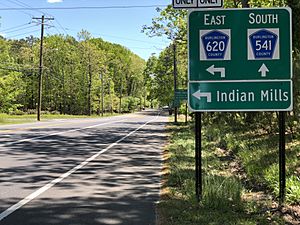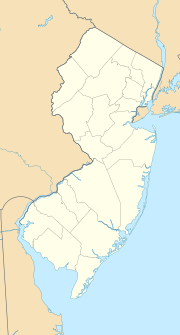Indian Mills, New Jersey facts for kids
Quick facts for kids
Indian Mills, New Jersey
|
|
|---|---|
 |
|
| Country | |
| State | |
| County | Burlington |
| Township | Shamong |
| Elevation | 75 ft (23 m) |
| GNIS feature ID | 877333 |
Indian Mills, once known as Brotherton, is a small, unincorporated community located in Shamong Township, Burlington County, New Jersey. An unincorporated community is a place that doesn't have its own local government but is part of a larger township or county.
Indian Mills is famous for being the site of the Brotherton Indian Reservation. This was the first Indian reservation ever created in America. It was set up for the Lenni Lenape tribe, who were the original Native American people of this area, including New Jersey's Washington Valley. Before it became a reservation, Indian Mills was an important industrial town. It had many gristmills (for grinding grain) and sawmills (for cutting wood). The town was also historically known as Edgepillock or Edgepelick.
Contents
History of Indian Mills
Early Relations and Disputes
In 1756, the British colonial government in America tried to solve problems between white settlers and the Munsee Lenape people. The Munsee Lenape were a group within the larger Lenape tribe. For about 100 years before this, the Native Americans and settlers had lived together peacefully.
However, disputes began to grow. The colonial government decided to appoint special officials called commissioners. Their job was to try and resolve these disagreements.
The Brotherton Reservation is Formed
In 1757, a group called the "New Jersey Association for Helping the Indians" wrote a plan. This plan aimed to move the Munsee Lenape people from their homes in the Washington Valley.
Reverend John Brainerd led the effort to forcefully relocate about 200 Lenape people. They were moved to Indian Mills, which was then known as Brotherton. This marked the beginning of the Brotherton Indian Reservation.
Life on the Reservation
Life on the reservation became very difficult for the Lenape people. In 1777, Reverend John Brainerd, who had been involved in their relocation, left the reservation. This made things even harder for the community living there.
In 1780, the Munsee Lenape leaders of Brotherton, many of whom were from the Washington Valley, wrote an important treaty. A treaty is a formal agreement. In this treaty, they firmly stated that they would not sell any more of their land to white settlers. They wanted to live peacefully and keep their land for their own community. They believed that having white neighbors on their land would cause problems and disagreements.
Moving West: Displacement of the Lenape
Displacement to Stockbridge, New York
In 1796, the Oneidas, another Native American tribe, invited the Lenape families from Brotherton to join their reservation. This reservation was located in Stockbridge, New York.
At first, the Lenape people did not want to leave. In 1798, leaders like Bartholomew Calvin and Jason Skekit, along with 18 others, signed a public statement. They refused to leave "our fine place in Jersey."
However, by 1801, many Munsee Lenape families decided to move. They relocated to New Stockbridge, New York to live with the Oneidas. A few Munsee Lenape individuals chose to stay behind in New Jersey. They eventually blended in with the white colonists who lived there.
Displacement to Green Bay, Wisconsin
The displacement of the Lenape people continued. In 1822, the remaining Lenape families were forcefully moved again. This time, they had to travel over 900 miles away to Green Bay, Wisconsin. This marked the end of the Brotherton Indian Reservation in New Jersey.




